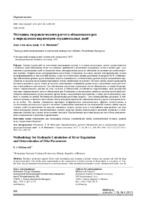Методика гидравлического расчета обвалования рек и определения параметров оградительных дамб
Another Title
Methodology for Hydraulic Calculation of River Regulation and Determination of Dike Parameters
Bibliographic entry
Михневич, Э. И. Методика гидравлического расчета обвалования рек и определения параметров оградительных дамб = Methodology for Hydraulic Calculation of River Regulation and Determination of Dike Parameters / Э. И. Михневич // Наука и техника. – 2017. – № 4. - С. 298-303.
Abstract
Защита территорий от затопления паводковыми водами и создание польдерных систем осуществляются с помощью дамб обвалования. Одно из основных требований к компоновке польдерных систем в поймах рек – размещение оградительных дамб за пределами пояса меандрирования русла во избежание их размыва при развитии речных излучин. Ширина пояса меандрирования может быть установлена на основе анализа топографических съемок руслоформирования за многолетний период, а при отсутствии таких данных рассчитана по формуле Б. Ф. Снищенко. При обваловании речного русла пойменная емкость уменьшается, соответственно уровень воды в междамбовом пространстве и скорость прохождения паводкового потока значительно возрастают. Поэтому дамбы следует располагать на таком удалении от русла, чтобы не вызвать существенного повышения уровня воды и увеличения скоростей течения в междамбовом пространстве. Для обоснования проектных параметров систем обвалования, создания благоприятного гидравлического режима на этих системах и обеспечения устойчивости оградительных дамб разработана методика гидравлического расчета обвалования рек. Основными ее фрагментами являются расчеты пропускной способности обвалованного русла и подъема уровня воды в междамбовом пространстве, а также расстояния между дамбами и отметки их гребня. Особенность предлагаемых расчетных формул – учет взаимодействия руслового и пойменного потоков, в процессе массообмена между которыми происходят замедление потока в русле и ускорение потока на пойме. Это явление учитывается введением коэффициентов кинематического эффекта соответственно к составляющим расхода воды в русле и на пойме. Приведенные зависимости для определения отметки гребня оградительных дамб (соответственно их высоты) учитывают подъем уровня воды в междамбовом пространстве для двух типов польдерных систем: не затапливаемых (зимних) дамб при уровне максимального весеннего половодья и затапливаемых (летних) при уровне летне-осенних паводков. Предложенные расчетные формулы могут быть рекомендованы к применению в проектных организациях.
Abstract in another language
Territory protection against flood water inundation and creation of polder systems are carried out with the help of protection dikes. One of the main requirements to the composition of polder systems in flood plains is a location of border dikes beyond meander belt in order to avoid their erosion when meander development occurs. Meander belt width can be determined on the basis of the analysis of multi-year land surveying pertaining top river-bed building and in the case when such data is not available this parameter is calculated in accordance with the Snishchenko formula. While banking-up a river bed a flooded area is decreasing and, consequently, water level in inter-dike space and rate of flood water are significantly increasing. For this reason it is necessary to locate dikes at a such distance from a river bed which will not cause rather high increase in water level and flow velocity in the inter-dike space. Methodology for hydraulic calculation of river regulation has been developed in order to substantiate design parameters for levee systems, creation of favourable hydraulic regime in these systems and provision of sustainability for dikes. Its main elements are calculations of pass-through capacity of the leveed channel and rise of water level in inter-dike space, and distance between dikes and their crest level. Peculiar feature of the proposed calculated formulae is an interaction consideration of channel and inundated flows. Their mass-exchanging process results in slowing-down of the channel flow and acceleration of the inundated flow. This occurrence is taken into account and coefficients of kinematic efficiency are introduced to the elements of water flow rate in the river channel and flood plain, respectively. The adduced dependencies for determination of a dike crest level (consequently their height) take into consideration a rise of water level in inter-dike space for two types of polder systems: non-inundable (winter) dikes with maximum spring flood rate and inundable (summer) dikes with summer-autumn flood rates. The proposed calculated formulae can be recommended for application at design organizations.
View/
Collections
- №4[11]

